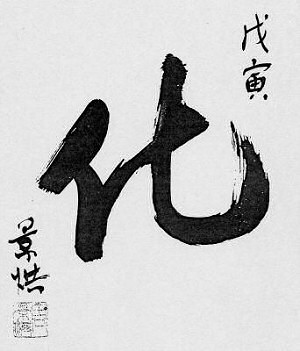
Calligraphed by Zhou Jing Hung
Huà is an ideogram in ancient Chinese which translates as “metamorphosis”, depicting a living man standing facing a man lying dead on the ground. Metamorphosis affects one’s way of being, but not one’s energy, which remains constant despite any change in form. Metamorphosis distinguishes itself from “change” (Bian), where the form remains constant but the energy has changed its path.
For the ancient Chinese, a radical trans-formation of a shape did not necessarily imply a change in its being. Using the picto-gram and its figurative representation as well as the ideogram which links it at several levels, the Chinese language reaches deep into our intuition and our senses as well as our capacity to conceptualise before this process can be organised into words, concepts or ideas. It is like being able to reach, to touch a man’s heart.
This way of thinking, of imagining the world, has something in common with dance, which reaches us in the same fashion, creating a personal space of “non-thought” before it is overridden by too much “thought”. The dancer’s body is what gives dimension and depth to this space, introducing us to a different way of being, a different way of thinking.
“Hua, a living man facing a dead man” is another step in my choreographic research involving transformation, mutation, form and energy, and the use of the body as a powerful symbol of the “non-thought” movements in dance.